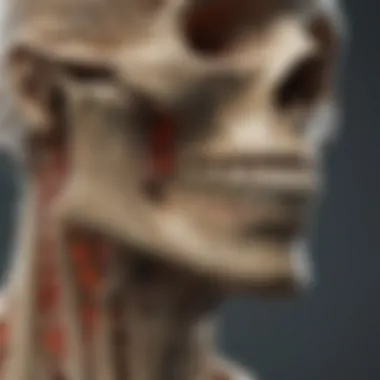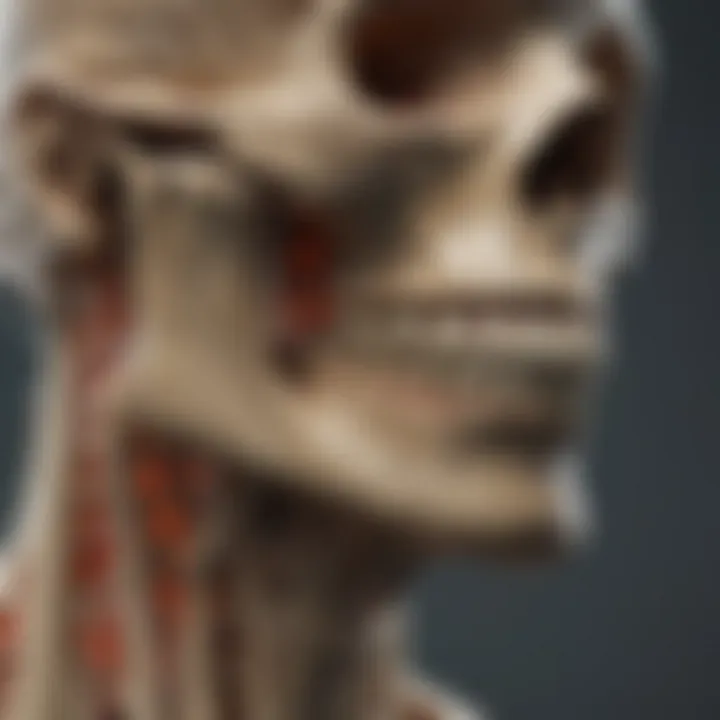The Impact of Radiation on Bone Density and Health


Intro
Radiation exposure is a concern in various fields including medicine, nuclear energy, and environmental science. Understanding its effects on bone density is essential due to the implications for public health. As researchers and health professionals continue to study this topic, findings indicate that radiation may lead to significant changes in bone structure, potentially contributing to conditions like osteoporosis.
Article Overview
Purpose of the Article
This article aims to delve into the intricate relationship between radiation exposure and bone density. By examining the underlying biological mechanisms, we will connect how ionizing radiation impacts cellular functions leading to alterations in bone health. Ultimately, the goal is to inform and educate various stakeholders about the potential risks.
Relevance to Multiple Disciplines
The investigation into radiation's effects on bone density is relevant across multiple disciplines such as:
- Medicine: understanding the health risks associated with radiation treatment.
- Occupational Health: identifying safety measures for workers in high-radiation environments.
- Environmental Science: analyzing risks from radioactive materials in the environment.
Research Background
Historical Context
Radiation has been both a tool for scientific advancement and a cause for concern in health sectors. Historical events, like the atomic bombings in Hiroshima and Nagasaki, highlighted acute radiation exposure's immediate effects. Subsequent studies have focused on its long-term impact on bone health, revealing critical insights over decades.
Key Concepts and Definitions
To effectively analyze the radiation's impact on bone density, clarity in key concepts is essential:
- Bone Density: a measure of the amount of mineral content in bones, an indicator of bone strength.
- Ionizing Radiation: high-energy radiation that can remove tightly bound electrons from atoms, creating ions.
- Osteoporosis: a condition where bones become weak and fragile, increasing the risk of fractures.
Impact of Radiation on Bone
The relationship between radiation and bone density is influenced by several factors. Studies suggest that both high doses of radiation and chronic low-level exposure can lead to bone loss. This loss may be mediated through cellular pathways affecting osteoblast and osteoclast activity.
"Understanding these mechanisms is crucial for developing safety norms and therapeutic interventions to mitigate risks associated with radiation exposure."
"Understanding these mechanisms is crucial for developing safety norms and therapeutic interventions to mitigate risks associated with radiation exposure."
Epidemiological Studies
Epidemiological data provide insights into real-world implications of radiation exposure. Various studies link occupational exposure in industries, such as healthcare and nuclear energy, to increased rates of bone density loss and osteoporosis among workers.
Fatigue, increased fractures, and various forms of bone pain are noted in individuals with significant radiation exposure. Such findings underscore the need for rigorous monitoring and preventive approaches in exposed populations.
Closures
As radiation continues to be utilized in various sectors, it is essential to investigate its influence on skeletal health. While the mechanisms are complex, the implications for public health are clear. Ongoing research is necessary to develop guidelines and preventive measures, ensuring individuals are aware of the risks associated with radiation exposure.
More comprehensive studies would allow for a better understanding of this relationship, helping practitioners in their work with at-risk populations.
Prelims to Radiation and Bone Health


Understanding the impact of radiation on bone health is crucial in the fields of medicine and environmental science. Radiation exposure, whether from medical treatments, occupational hazards, or environmental sources, can lead to significant health implications, particularly concerning bone density. The bones are dynamic structures that constantly undergo remodeling, balancing the activities of osteoblasts and osteoclasts. However, radiation can disturb this balance, potentially leading to osteoporosis and increased fracture risk.
In this section, we will delve into the types of radiation that are pertinent to bone health and provide an overview of the essential features of bone structure and function. By exploring these topics, we can better appreciate how radiation affects bones and recognize the underlying biological processes involved.
Understanding Radiation Types
Radiation encompasses a range of energy forms that can interact with matter. Broadly, it is categorized into two main types: ionizing and non-ionizing radiation.
- Ionizing Radiation: This type carries enough energy to dislodge electrons from atoms, creating ions and potentially damaging cellular structures. Sources of ionizing radiation include X-rays, gamma rays, and particles such as alpha and beta radiation. Ionizing radiation is particularly significant in medical settings, especially in cancer treatment where high doses may be employed.
- Non-Ionizing Radiation: This type does not have sufficient energy to ionize atoms. Examples include visible light, infrared radiation, and radio waves. Although generally considered less harmful, prolonged exposure to non-ionizing radiation can still pose risks under certain conditions.
Overview of Bone Structure and Function
Bone is a complex organ that performs several critical functions within the body. It provides structural support, facilitates movement by serving as attachment points for muscles, protects vital organs, and plays an essential role in mineral homeostasis.
Main Components of Bone:
- Osteoblasts: Cells responsible for bone formation. They synthesize bone matrix and are involved in mineralization.
- Osteoclasts: Cells that break down bone tissue. They play a vital role in the remodeling process and calcium release into the bloodstream.
- Osteocytes: Mature bone cells that maintain the bone matrix and communicate with other bone cells to coordinate remodeling activities.
Bone density reflects the amount of bone mineral content in a given volume of bone. High bone density is generally associated with increased strength and a lower risk of fractures. Conversely, low bone density can increase vulnerability to fractures, particularly in older adults and those exposed to certain risk factors such as radiation.
By understanding the interaction between radiation types and the intricate mechanisms of bone health, we can begin to clarify the potential risks involved in radiation exposure and outline strategies for minimizing these risks.
Mechanisms of Bone Density Alteration by Radiation
Understanding the mechanisms by which radiation affects bone density is essential for evaluating the long-term implications of exposure. These mechanisms provide insight into how radiation can lead to decreased bone health, which is crucial for preventing conditions such as osteoporosis. By analyzing how radiation interacts with bone cells, we can better identify potential risks and develop strategies to mitigate these effects.
Cellular Response to Radiation
When bone tissue is exposed to radiation, it triggers a complex cellular response. One of the initial reactions involves the generation of free radicals. These highly reactive molecules can cause oxidative stress, leading to cellular damage. In bone tissue, the primary cells affected are osteoblasts and osteoclasts.
Osteoblasts are responsible for bone formation, while osteoclasts facilitate bone resorption. The imbalance induced by radiation can significantly disrupt the normal remodeling process. Evidence suggests that radiation can alter gene expression within these cells, potentially impairing their function. This cellular disruption can lead to diminished bone mass over time, making it a critical area of research in understanding bone density loss due to radiation exposure.
Impact on Osteoblast Function
Osteoblast function is a pivotal aspect of bone health, as these cells are tasked with synthesizing new bone matrix. Radiation can negatively influence the proliferation and activity of osteoblasts. Studies have shown that exposure to ionizing radiation can reduce the viability of these cells. This reduction means fewer osteoblasts are available to contribute to bone formation.
Additionally, radiation exposure can hinder the differentiation of stem cells into osteoblasts. This impediment contributes to a decrease in new bone synthesis, thereby affecting overall bone density. If osteoblast function is compromised, the body's ability to maintain and repair bone tissue is also impaired, increasing the risk of future fractures.
Influence on Osteoclast Activity
While osteoblasts are responsible for forming bone, osteoclasts play a crucial role in bone resorption. Studies indicate that radiation can enhance osteoclast activity, leading to increased bone loss. The mechanisms by which radiation increases osteoclast formation are not entirely understood, but it is clear that the damage inflicted on the surrounding bone environment can create signaling pathways that promote osteoclastogenesis.
With an elevated osteoclast activity, the balance between bone resorption and formation becomes skewed. This change is particularly concerning, as excessive bone resorption can lead to decreased bone density over time.
In summary, the interaction of radiation with cellular components of bone results in a cascade of effects that adversely influence both osteoblasts and osteoclasts. Understanding these mechanisms is crucial for developing effective interventions aimed at preserving bone density in individuals exposed to radiation.
Epidemiological Evidence Linking Radiation to Bone Loss
Understanding the connection between radiation exposure and its impact on bone loss is crucial for public health and safety. Epidemiological evidence offers a pathway to analyze how radiation affects bone density in various populations. This understanding can guide policy decisions, shape health guidelines, and inform individuals who may be at risk due to occupational hazards or environmental exposure.


The significance of epidemiological studies lies in their ability to provide data on real-world exposures. By evaluating populations exposed to radiation in different contexts, researchers uncover patterns that can indicate a relationship between radiation and skeletal health. Such evidence is vital not just for healthcare providers, but also for regulatory agencies that aim to mitigate risks associated with radiation exposure.
Studies of Nuclear Industry Workers
Nuclear industry workers are among the most studied groups regarding radiation exposure. Research consistently shows that prolonged exposure to ionizing radiation can lead to significant reductions in bone density over time. A notable study published in the International Journal of Radiation Biology illustrates that workers with high cumulative exposure showed a higher incidence of osteoporosis compared to their unexposed counterparts.
Investigations focused on specific job roles, like reactor operators and emergency responders, have revealed increased risk levels. Important findings suggest that as the dose of radiation increases, the risk of developing bone-related conditions also rises.
Effects in Radiotherapy Patients
Radiotherapy patients provide another critical context for examining how radiation influences bone health. Patients undergoing treatment for cancers, such as breast and prostate cancer, often receive radiation therapy that targets tumor growth. However, studies indicate that this therapy can inadvertently affect surrounding bone tissue, leading to decreased bone density.
A research analysis in the Journal of Clinical Oncology highlighted that patients receiving pelvic radiation developed more frequent fractures compared to those not exposed to radiation. The risk is particularly significant in older adults, who already have diminished bone reserves. Therefore, understanding radiation's impact becomes paramount for developing comprehensive care strategies in this patient population.
Environmental Exposure Research
Environmental exposure to radiation poses certain risks, especially in areas near nuclear waste sites or nuclear power plants. Research has shown that communities living near such locations have reported increased cases of bone loss. A key study conducted in regions surrounding Chernobyl provided compelling evidence of radiation exposure correlating with reduced bone mineral density in residents.
Researchers have been looking into how low-level, chronic exposure to radiation affects bone health. Findings suggest that environmental radiation can alter bone remodeling processes, compounding the risk of osteoporosis over a lifetime.
"Understanding the nuances of radiation exposure is essential for effective public health strategies and individual precautions."
"Understanding the nuances of radiation exposure is essential for effective public health strategies and individual precautions."
In summary, the epidemiological evidence linking radiation exposure to bone loss underscores the need for vigilance in various settings, whether occupational, medical, or environmental. This data forms the backbone for future research, enabling us to better protect populations at risk.
Radiation Exposure and Osteoporosis Risk
Understanding the connection between radiation exposure and osteoporosis risk is crucial in today's highly industrialized society. With various industries relying on radiation, both occupationally and in medical treatments, knowing the implications is essential for health and safety.
Relationship Between Radiation and Osteoporotic Fractures
Research indicates that exposure to radiation might significantly increase the risk of osteoporotic fractures. Osteoporosis is a condition characterized by reduced bone density, leading to a higher likelihood of fractures. Studies show that radiation can influence bone density negatively through multiple pathways.
- Direct Damage to Bone Cells: Radiation affects the viability and functionality of osteocytes, osteoblasts, and osteoclasts. The regeneration capabilities of these cells deteriorate with radiation exposure, leading to bone loss.
- Increased Fracture Risk: Individuals exposed to higher doses of radiation, such as those in nuclear industries or specific radiotherapy patients, often report higher incidences of fractures, especially in the hip and spine. This suggests a correlation that cannot be ignored.
In a certain study, patients undergoing certain cancer treatments displayed a significant increase in fracture rates, emphasizing the link between therapeutic radiation and bone fragility.
Long-term Effects of Radiation Exposure on Skeletal Health
The long-term impact of radiation exposure on skeletal health cannot be understated. Bone health is not merely about immediate effects, but also the implications that occur years after exposure.
- Cumulative Damage: Prolonged contact with radiation, even at lower levels, accumulates effects over time, which can manifest as chronic conditions affecting bone density.
- Hormonal Changes: Radiation may disrupt the hormonal axis that regulates bone remodeling. For instance, disruptions in estrogen levels due to radiation can lead to accelerations in bone loss, particularly in postmenopausal women.
- Potential for Late-Onset Osteoporosis: Individuals who have undergone radiation treatment may not notice the bone density loss until years after exposure. This often results in delayed diagnosis and treatment of osteoporosis, making preventive strategies vital.
The implications of these findings are significant. Not only do they underline the necessity of monitoring bone health in individuals with known radiation exposure, they call for stricter guidelines and preventative measures for those at risk.
The importance of understanding radiation exposure's impact on osteoporosis cannot be overstated. Protecting skeletal health is crucial for maintaining overall well-being, especially in high-risk populations.
The importance of understanding radiation exposure's impact on osteoporosis cannot be overstated. Protecting skeletal health is crucial for maintaining overall well-being, especially in high-risk populations.


Potential Mechanisms for Radiation-induced Bone Loss
Understanding how radiation affects bone density is essential for identifying and possibly mitigating the risks associated with exposure. This section delves into the specific mechanisms through which radiation can lead to bone loss. By examining these mechanisms, we not only gain insight into the biological processes involved but also highlight the significance of prevention and treatment strategies.
Inflammatory Responses Induced by Radiation
When bone tissue is exposed to radiation, inflammatory responses can be triggered within the body. These responses are often characterized by the recruitment of immune cells to the site of radiation exposure. The activation of these immune cells can lead to the release of pro-inflammatory cytokines. These biological markers can subsequently promote an environment that favors bone resorption, which is the process where bone tissue is broken down and its minerals released into the bloodstream. Additionally, inflammation may interfere with the normal function of osteoblasts, the cells responsible for forming new bone. Therefore, it is crucial that these inflammatory responses are understood and managed effectively. Studies indicate that controlling inflammation may not only protect bone density but also enhance healing in individuals exposed to radiation.
Hormonal Changes Affecting Bone Remodeling
Radiation exposure can also lead to hormonal changes that negatively impact bone remodeling. Hormones such as parathyroid hormone and calcitonin play pivotal roles in bone health. When radiation exposure occurs, the delicate balance of these hormones can be disrupted. For example, an increase in parathyroid hormone can enhance bone resorption and decrease osteoblast activity. On the other hand, radiation may lead to reduced levels of calcitonin, which normally acts to inhibit osteoclast activity, leading to an overall loss in bone density. Understanding these hormonal variations is essential for the development of treatment options that target these hormonal pathways effectively, aiming to restore the balance necessary for healthy bone maintenance.
"Addressing inflammatory responses and hormonal changes is critical in combating radiation-induced bone loss. These mechanisms are interlinked and need a comprehensive approach for effective management."
"Addressing inflammatory responses and hormonal changes is critical in combating radiation-induced bone loss. These mechanisms are interlinked and need a comprehensive approach for effective management."
By focusing on these potential mechanisms for radiation-induced bone loss, we can better address the complexities of this health issue, providing pathways for future research and intervention aimed at preserving bone density in at-risk populations.
Preventative Measures and Treatment Options
The significance of discussing preventative measures and treatment options in the context of radiation's impact on bone density cannot be overstated. Radiation exposure, whether from occupational hazards or medical treatments, raises concerns regarding bone health. It is imperative to explore strategies that can mitigate these effects. This section will detail approaches that can help preserve bone integrity and overall skeletal health.
Calcium and Vitamin Supplementation
Calcium and Vitamin D are key nutrients that play a critical role in maintaining bone density. Calcium is the primary mineral found in bones. It serves as the foundation that supports bone structure and strength. Vitamin D, on the other hand, is vital for the absorption of calcium in the intestines. Individuals exposed to radiation may experience changes in their bone metabolism, making adequate intake of these nutrients essential.
Supplementing with calcium can help counteract any potential bone loss due to radiation. The recommended dietary allowance for calcium varies by age and gender but typically falls around 1,000 to 1,200 mg per day for adults. Foods rich in calcium include dairy products, leafy greens, and fortified foods.
Also, vitamin D can be synthesized through sun exposure or from dietary sources like fatty fish and fortified foods. The recommended daily allowance is around 600 to 800 IU for most adults. However, some studies suggest that those at higher risk for bone loss may benefit from higher doses. Monitoring vitamin D levels is important, as low levels can lead to decreased calcium absorption and increased bone fragility.
"Adequate calcium and vitamin D intake is an integral part of protecting skeletal health from the adverse effects of radiation."
"Adequate calcium and vitamin D intake is an integral part of protecting skeletal health from the adverse effects of radiation."
Lifestyle Modifications for Bone Health
Lifestyle choices significantly impact bone health. Integrating specific habits not only helps in reducing the negative effects of radiation but also promotes overall skeletal well-being. Here are some critical lifestyle modifications:
- Regular Weight-bearing Exercise: Engaging in activities such as walking, jogging, dancing, or resistance training can improve bone density. These exercises stimulate bone formation, helping to offset the potential loss from radiation.
- Avoid Smoking and Limit Alcohol Intake: Both tobacco and excessive alcohol consumption are known to harm bone health. Smoking can interfere with bone cell activity, while high alcohol intake can inhibit calcium absorption.
- Nutrition Focus: A balanced diet rich in fruits, vegetables, lean protein, and whole grains supports not just bones but overall health. Nutrient-dense foods provide essential vitamins and minerals that contribute to bone health, complementing calcium and vitamin D.
- Regular Health Check-ups: Routine screenings can help monitor bone density. Early detection of bone loss can lead to timely interventions, minimizing potential complications like fractures.
Incorporating these lifestyle changes not only fosters bone health but translates to better quality of life. It requires a commitment to long-term health, particularly for individuals with heightened exposure to radiation. By emphasizing preventive measures, we can effectively address the risks associated with radiation and maintain optimal bone density.
Epilogue
Summary of Findings
Research has shown that radiation can significantly affect bone density through various mechanisms. Key findings include:
- Reduction in Osteoblast Activity: Radiation exposure leads to diminished function of osteoblasts, the cells responsible for bone formation, resulting in decreased bone density.
- Increased Osteoclast Activity: There is evidence suggesting that radiation may enhance osteoclast activity, leading to increased bone resorption and further contributing to bone loss.
- Inflammatory Responses: The inflammatory cascade initiated by radiation exposure can disrupt normal bone remodeling processes, exacerbating bone density issues.
- Epidemiological Evidence: Studies involving nuclear workers and radiotherapy patients consistently demonstrate a correlation between radiation exposure and increased risk of osteoporosis and related fractures.
These findings underscore the multifactorial nature of bone health and highlight the significant impact of external factors like radiation on skeletal integrity.
Future Directions for Research
Future studies should focus on several critical areas:
- Longitudinal Studies: More extensive long-term studies are needed to assess the cumulative effects of radiation on bone density over time.
- Mechanistic Research: Identifying specific biological pathways affected by radiation can aid in developing targeted therapeutic strategies to prevent bone loss among exposed populations.
- Preventive Strategies: Investigating effective interventions, such as pharmacological treatments or lifestyle modifications, to offset radiation's negative impact on bone health is essential.
- Diverse Populations: Studies should encompass a wider range of populations, including those at environmental risk, to capture a holistic view of radiation's impact.



